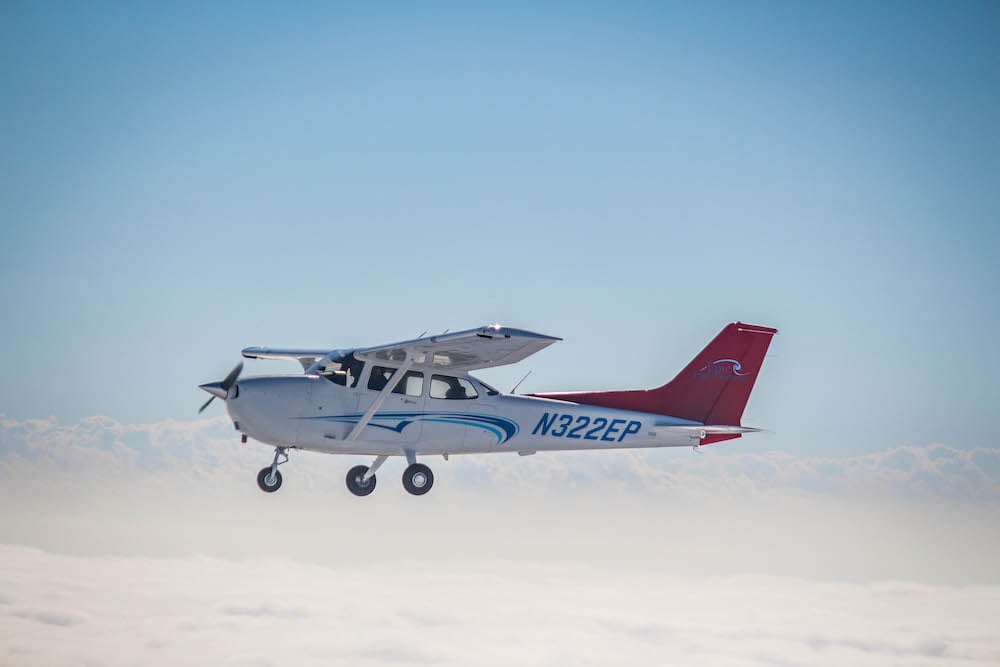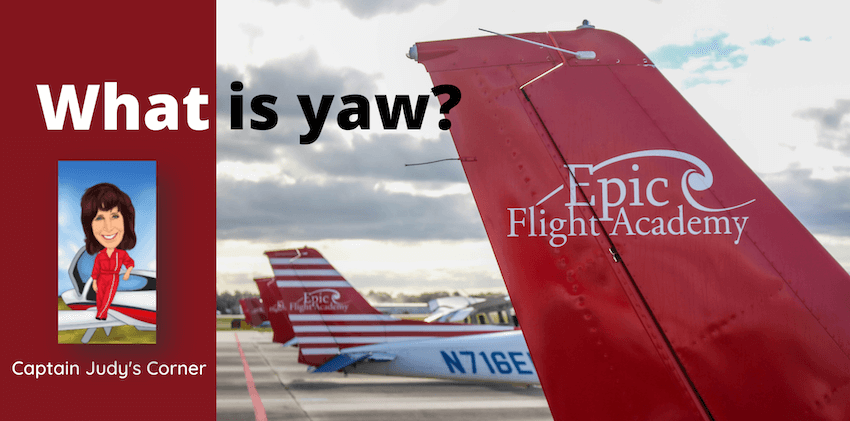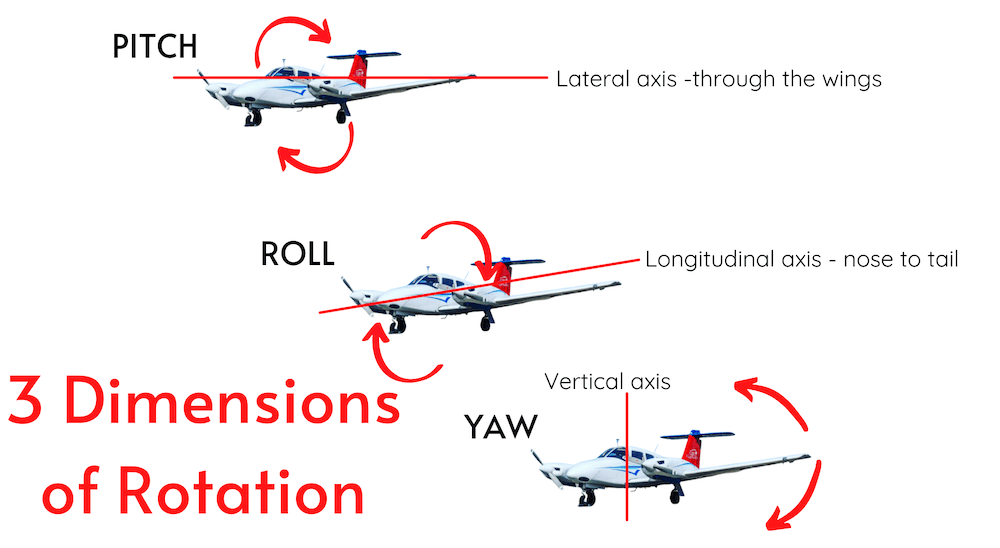What is yaw? What does ‘yaw’ mean? The official definition is a twisting, or rotation of up to 360 degrees, of a moving ship or aircraft around a vertical axis. To define yaw is to describe an airplane, boat, or even a fish with the nose or front moving side-to-side through the air. Motion determines the meaning. Do cars or motorcycles yaw? Ground vehicles move in two dimensions and do not yaw. However, even wind turbines have yaw motors, which help generate as much wind power into electricity as possible.
Yaw rate sensors are used in aircraft to measure yaw rate, the angular velocity around the plane’s vertical axis. Yaw rate directly relates to lateral acceleration of the plane as it turns at a constant speed around a radius. Refer to the Pilot’s Operating Handbook for your aircraft to view the checklist step for the yaw damper. An example of yaw is a plane’s motion as it swings back and forth across its flight path. Not always a pretty picture!
What are the three dimensions of airplane movement?
Aircraft move in three dimensions, which adds to the complexity of stability and control. Therefore, a change in any one of a plane’s three dimensions of motion affects the other two. Yaw is one of these dimensions. The other two are roll and pitch.
Imagine three lines drawn on an airplane. One line is nose to tail, another up and down, and the third line wingtip to wingtip. The three lines, called axes, are an airplane’s three dimensions of motion and intersect at the center of gravity. A pilot rotates the airplane around the center of gravity.
In aviation, a pilot controls the three axes from the cockpit using a control yoke or a control stick and rudder pedals that are connected to outside control surfaces. These primary flight controls are moveable surfaces. Also, some advanced aircraft have the option or are required to use technology assisting with controlling the axes.
Three Axes
Longitudinal Axis – Roll
The longitudinal axis is the axis line from the aircraft nose to tail and controls the roll movement. Ailerons are the primary flight control that roll the aircraft. They are located on the outside, trailing edge of each main wing. When a pilot moves the control yoke left or right, they are controlling the ailerons.
Lateral Axis – Pitch
The line from wingtip to wingtip is the lateral axis, which controls the pitch movement. Therefore, when the pilot moves the control yoke forwards or backwards, they control the elevator. The elevator, a primary flight control, controls pitch movement. Some aircraft have a different control surface that controls pitch, known as a stabilator. The elevator or stabilator is located at the trailing edge of the airplane’s horizontal tail wing, called the horizontal stabilizer.
Vertical Axis – Yaw
The up and down axis is the vertical axis, which controls the yaw movement. The rudder is the primary flight control that controls yaw. The rudder is located along the trailing edge of the vertical tail fin, called vertical stabilizer. As the rudder moves from side to side, the tail moves in a left or right direction. The two rudder pedals located on the floor directly in front of the pilot controls the outside rudder control surface.
Coordination is the pilot’s ability to subconsciously use their hands and feet together to produce desired results in the airplane. Coordinated flight requires the pilot to use pitch, roll, and yaw simultaneously. Today, the forces felt by the pilot and instruments in the cockpit assist pilots to maintain coordination.
Why is understanding yaw important?
For pilots to fly responsively to an aircraft’s motion, they need to understand forces like yaw, pitch, and roll. Before modern instrumentation, pilots invented a yaw string, also called a slip string. The yaw string is a short piece of yarn that pilots place free of the disruptive air stream on the outside of the aircraft’s nose in front of the pilot’s view. If the yaw string blows to one side or the other, the pilot needs to place more rudder pressure on the side of the string to center the string. Still today, some aircraft attach a yaw string indicating coordinated movement about the vertical axis. Today, an online calculator can determine yaw, pitch, and roll.
Most aircraft are now equipped with a turn coordinator. This instrument senses rolling, yawing, and turning movements displaying the rate and coordination of a bank. Pilots display coordination by an inclinometer in relationship between the bank angle and the rate of yaw. The bank indicator displays units of degrees per second or minutes per turn.
Controlling Yaw
When entering a bank, there is a difference of lift and drag on each wing causing an aircraft to yaw in the opposite direction of a roll. This is adverse yaw. It requires the pilot to add more rudder input momentarily in the opposite direction of a turn when entering a bank. Some aircraft, such as Epic Flight Academy’s Cessna 172s, were designed with ailerons that create more drag when in an upward position minimizing the effects of adverse yaw.
Pilots use a yaw damper to reduce the tendencies of an aircraft to oscillate in a repetitive rolling and yawing motion. Therefore, this automatically reduces a pilot’s workload. On some aircraft, it is mandatory for the yaw damper to be operational at all times during flight when reaching a specified altitude. The design of these aircraft may be unsafe to fly without an active yaw damper.
How does yaw affect flight training?

Aircraft with swept back wings have a natural tendency to yaw and require an automatic rudder assisting the pilot’s workload. Aircraft designed to travel distances, such as the Citation jet and commercial airlines, have instrumentation and technology assisting a pilot to fly coordinated, such as the yaw damper. Manufacturers design maneuverable aircraft, such as aerobatic aircraft, for precise inputs by the pilot at all times when controlling the three axes.
Student pilots typically train in easily controlled, well-designed aircraft. Aircraft manufacturers design planes with high levels of stability about the three axes to avoid dangerous situations. Pilots learn calibration and how to adjust the roll, pitch, and yaw responses.
Fundamentals
One of the fundamental skills for student pilots is to understand these forces on their aircraft while remaining in coordinated flight. Epic’s flight school offers superior ground schools where instructors plan lessons to demonstrate yaw. Epic’s outstanding flight training team, new Cessna 172 aircraft, and full-motion simulator provide students every opportunity for success.
Those interested in learning more about yaw may download yaw virtual reality controller apps. This simulates the sensation of yaw.
We climbed effortlessly in the Citation Jet to our assigned altitude of FL380 (38,000’MSL). This light jet is controlled much like most commercial jets and with similar design features. One of the Citation’s smooth handling characteristics in a climb are the result of the yaw dampers. The Citation has vertical fins under the tail cone and an electronic yaw damper engaging automatically when the yaw is overpowering the vertical fins.
–Captain Judy Rice on her around-the-world flight




What is the relation between Yaw angle and speed and directions of wind in a Wind in a wind turbine ?
We asked Captain Judy about this, and here’s what she shared:
Aerodynamics often do not have straightforward answers.There are many variable effects. Longitudinal axis as a design feature would not change in the given airplane. The angle difference between the longitudinal axis and the given wind direction would change. Depending on the variables including the wind turbine blades, exceeding the angle difference regardless of wind speed or direction of wind.